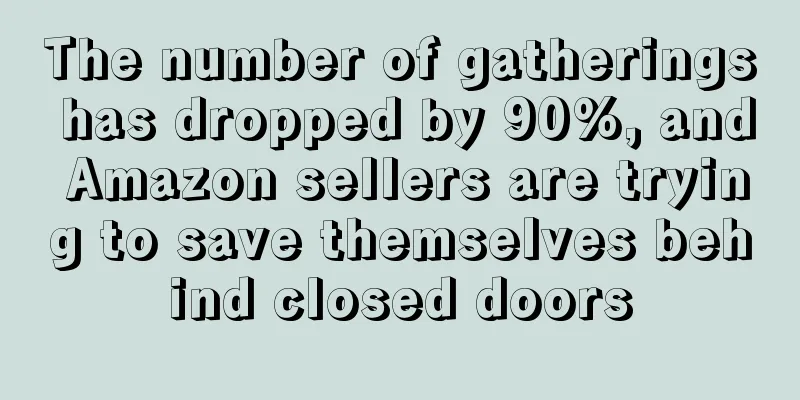The number of gatherings has dropped by 90%, and Amazon sellers are trying to save themselves behind closed doors

|
This year, the sales and profits of many cross-border sellers have both declined, especially those affected by account bans, whose sales have even dropped by 80%. Cross-border sellers can no longer afford any risks, so they have begun to tie themselves up with factories and embark on a path of self-rescue behind closed doors.
Seeing the difficult situation of the sellers around them, many of their peers said they wanted to just lie down, but cross-border people can never just lie down! In the new situation where big sellers are trying to save themselves behind closed doors and factories are trying to intervene in the industry, lying down may have become equivalent to being eliminated. Where will the survival space for cross-border sellers be in the future?
Sales of top sellers dropped by 80% , and losing money has become the norm for cross-border people
2021 is coming to an end, and this year may be the most challenging year for cross-border e-commerce sellers. Since Amazon banned its accounts at the end of April, cross-border sellers in the industry have been wailing. Currently, this action by the platform is still ongoing, and almost no one dares to easily touch the red line of violations.
Under the influence of the account suspension wave, some Amazon sellers have suffered heavy losses. Shenzhen billion-level seller Dabing said that at the beginning of the year, everyone predicted that the account suspension would end on September 30, but it continued in October. Later, it was predicted that it would end in Q4, but it is still continuing, so Amazon's rectification is likely to continue.
The logic behind the account blocking is not only a violation of the rules of the Amazon platform, but also a violation of American values. They originally believed in something unconditionally, but when a large amount of evidence is presented in front of them, they have to believe that there is water in it.
When Amazon sellers use small cards to break through the American cognition, it is a harm to the platform. It needs to use certain means to maintain loyal users. If customers are lost, it may shake the traffic foundation of Amazon. This may be the reason why Amazon vigorously regulates and bans sellers’ accounts. Moreover, over time, Amazon found that banning some sellers did not have much impact on the overall GMV of the platform , because the sellers provide standard products. If a product fails, a substitute will soon appear.
Amazon can sit back and relax, but domestic sellers are clearly overwhelmed. According to Da Bing, some of the most severely affected top sellers may have lost about 80% of their sales. A seller who has been in the industry for 5 years said that this year is the worst year, and many of his peers, including himself, have no orders, and sales have dropped to a freezing point. Some sellers have to make internal rectifications, company transformation, layoffs to save lives, and other operations are common.
Chen Xianting, vice president of Yicang Technology, believes that many Amazon sellers are having a hard time this year. But this also needs to be viewed in layers: first , it is definitely difficult for sellers who sell goods in bulk, especially those who do not have core capabilities ; second, small sellers, especially those who have just entered the market this year, currently there is no such a big bonus on the platform to feed them . However, some sellers who have been focusing on high-quality products for two or three years have not been affected, and some are even living a more comfortable life.
However, for sellers, the most fatal point is not sales, but profits. The hottest words in the industry this year are price wars and internal circulation. With the superposition of multiple factors such as rising freight prices, rising advertising costs, and falling exchange rates, losing money has become the norm for a large number of sellers.
The number of gatherings dropped by 90%, and Amazon sellers closed their doors to save themselves
A billionaire seller said that many people doing cross-border business are losing money this year, which has basically become the norm. I often make a joke: last year, our industry seller friends would often have private gatherings, but this year there are fewer such activities, probably only one-tenth of last year's. From this superficial phenomenon, we can see that every company in the industry is closing down to save themselves, and everyone is trying to find ways to move forward.
An industry insider has done the math and found that Amazon's commission + delivery fee is about 35%-40%, minus the European VAT fee of 20%, the first-leg freight fee of 17%-20%, the procurement cost of 15%-20%, the operating cost of 5%, and the advertising cost of 5%. The product profit margin must be at least 130%, otherwise there will be no profit.
When costs are rising, many competitors do not raise prices, but instead engage in price wars. Especially around this year's Member Day, Amazon sellers all cleared out their inventory at bargain prices, and their identities transformed into cross-border philanthropists. As time goes by to Black Friday, there are still many sellers clearing out their inventory at low prices, and the price war is still going on. One seller joked: The more you sell, the more you lose, and the less you sell, the more you lose!
Can't you raise prices if your profits are hurt? Such soul-searching questions often leave cross-border people speechless. "The entire category is in a price war, and you can see the lowest prices you can't imagine every day. The top 1 in some categories is directly available for 0 yuan purchase. If you don't lower the price, you can only pile up the goods in the warehouse, and you have to pay high storage fees for the backlog of goods. There is no other way!" a Shenzhen seller lamented.
Mumu, another Shenzhen seller, mainly sells 3C products. Affected by the overall environment, this year's sales are only two-thirds of last year's, and profits have been cut in half. The peak season, which was originally expected, has almost the same sales as usual. Sellers on the Japanese site followed the trend of selling thermal underwear. Due to the high value of the product and fierce competition, a lot of inventory was accumulated, with a value of up to 4 million. There was a problem with the account, and the 4 million inventory was piled up in the Amazon warehouse.
Not only small and medium-sized sellers, but also large sellers suffered even greater losses. From January to June this year , Youkeshu's revenue was 1.092 billion yuan, a year-on-year decrease of 51.12%, and its net profit loss was 742 million yuan.
In addition to force majeure such as shipping costs and exchange rates, the impact of account suspension on profits is reflected in the surge in advertising costs. Compared with before the suspension, the real feedback from sellers is that advertising costs have become more expensive.
"As an Amazon seller, if you want to get more orders, it is directly linked to the conversion of traffic programs. Traffic is divided into active traffic and passive traffic. Passive traffic comes from the platform's allocation; active traffic requires sellers to take the initiative to buy. Active traffic is related to pictures, QA, descriptions and comments, and the most difficult to control is evaluation. In the past, sellers brushed orders in order to increase conversion and weight through evaluation and bring in passive traffic. Now the road to brushing orders is blocked. If you want to get more orders, you must do more on-site advertising to a certain extent." said Dabing.
As profits continue to decline, many Amazon sellers have mentioned a term called "lying flat."
Cross-border sellers can never lie flat
To some extent, the sellers who lie flat depend on the situation, and can be basically divided into two categories: 1. Sellers who have too much inventory to clear out the inventory; 2. Sellers who have inventory pressure after their accounts are blocked and sell out the inventory at super low prices without considering the cost. This year, these two types of sellers account for a large part.
Sellers outside of the two categories may not be able to exist. Cross-border people often use two major directions to describe their categories, namely red ocean categories and blue ocean categories.
For example , the hot 3C category is a red ocean category. 3C products are easy to aggregate, because the ability to aggregate will form some big hits. Perhaps one product can equal the profit of a listed company. This often happens in Shenzhen. Da Bing, who works in the 3C category, has a deep understanding of this.
However , there is great competition in 3C products. Since online display is transparent, competitors can conduct a thorough and long-term tracking and analysis of your products, so it is easy to grasp your changes. After obtaining information about competitors, competition between sellers will always exist. Sellers who want to reap the benefits of hot products must always follow up on various feedbacks, and even bargain at high prices to maintain their rankings. There is no way to stay flat.
Sellers who have been looking for blue ocean categories may just want to find a flat state. Da Bing bluntly said that blue ocean sellers just want to take advantage of the information gap and hide in a corner that others can't see. As market competition intensifies, sellers in the red ocean will definitely sink to the next level market. When the red ocean team sinks to the blue ocean field, sellers who live in a flat state will have no power to fight back.
Therefore, blue ocean sellers cannot just sit back and do nothing. Once they have found a suitable category, they must accumulate advantages when there is an information gap. Only by accumulating advantages and becoming the leader can they maintain their position. When other sellers from red ocean categories enter the market, these advantaged sellers have already established a firm foothold and others cannot shake them at all. If a team just sits back and does nothing to reap the dividends of blue ocean categories, it is very dangerous. As cross-border e-commerce has developed to this day, the time for information gaps has become shorter and shorter, and the time left for sellers is also shrinking.
Another factor that prevents cross-border sellers from doing nothing comes from the factories. Previously, factories that entered the cross-border e-commerce market generally did not have operational advantages. There were cases where factories lost millions after transforming to sell to Amazon. However, this year the identity of the factories seems to have changed, and they easily became participants in cross-border e-commerce.
As the stocking season arrives, sellers are tied to factories to hedge risks
The peak season has not yet ended, but it is time to prepare for the new year. Some sellers remind that they need to start preparing for the new year this month. Many factories will be closed at the end of the year, and even if they resume work in the first month of the new year, the production capacity will not be too high.
In the past week or two, most sellers have been busy preparing for the Spring Festival and next year's sales. In the sellers' words, they have to prepare for the sales even before the money they received has warmed up, and the profits earned during the peak season have returned to the value of the goods.
This year, many sellers have been put in a passive position due to improper stocking. Da Bing analyzed that the market has not grown, but everyone has so much stock, and last year's stock has not been sold out this year. In addition, the inventory of the banned big sellers has been released, and Amazon sellers are facing double inventory pressure. Once the clearance begins, sellers will not consider the cost, and even think that the money they can get back is profit, and finally clear the stock at the floor price.
Before preparing goods, sellers need to consider three questions: When to prepare goods? How much goods to prepare? How to prepare goods?
At the end of November, a seller said that taking the purchase plan for March next year as an example, now is a good time to purchase products. The reason is that the factory shipments are slow in January, and placing orders in advance is convenient for arranging production, and it can also estimate product sales and quality. "We usually prepare goods at least three months in advance, and some products have to be purchased half a year in advance because the production time of the products is too long. In order to prevent the midway out of stock, the factory raised the price, and the logistics and factory special reasons did not ship, so we have to start preparing now."
At present, some sellers have begun to prepare goods for the Spring Festival, with the preparation quantity being about one month to one and a half months. Most people will ship the goods before the logistics are stopped before the New Year.
In terms of stocking quantity, some sellers said that now is the time to test their courage in stocking, and they have to take a gamble in stocking without thinking to see if they can take advantage of the opportunity to overtake others; some sellers are forced to double or even triple their stocking due to logistics timeliness . "In the past, the 20-day shipping cycle only required a 2-month stocking cycle, but now the 2-month shipping cycle requires 6 months of stocking by the end of the year." said a seller. Another seller of high-value products said that his US market has already stocked until September next year, calling it too difficult.
A few sellers have no time to stock up, and they are still struggling to digest the excess goods they had previously stocked up.
"No matter how big a seller is, there will be times when they fail to estimate the inventory for the Christmas season. The big brother in our category probably stocked too much this year and is still giving benefits to Americans! The peak season is about to end, and it seems that the remaining inventory can be sold for another year next year. I just don't know if the storage fee of hundreds of thousands will be enough." The seller sighed.
After suffering from over-stocking this year, combined with the current sales environment, most sellers will stock within their means.
Chen Xianting believes that sellers stocking up is not a goal but a means, and this means is adjustable. Given this year's situation, sellers will be more rational next year and will not blindly stock up as much as last year. "I think the situation next year will be better than this year, because sellers have experienced many problems this year and are more capable, and the environment next year will be more certain."
In the middle of the year, a number of big sellers suffered from the wave of account bans, and many levels of the industry were affected, and new forms of stocking emerged.
Da Bing believes that this year's situation will trigger deep thinking in the industry: Will sellers continue to follow the previous (operation) model? That won't work. Relying on simple and violent methods to rush up will have serious consequences. If you die once, you can get up again, but if you die again, you basically can't get up.
Logistics is an important factor in the process of preparing goods. "In terms of transportation this year, we all agree that as long as civil aviation is not open, all logistics costs will not be reduced. Because in terms of air transportation, the volume of goods used by civil aviation channels is very large. If civil aviation is not open, air transportation will rely on special aircraft with very small volume, so the goods will inevitably be squeezed into the sea transportation channel. When sea transportation sees that you have no choice, it will raise the price."
At present, some air freight prices have exceeded 100 yuan/kg, and the overall shipping time of sea freight channels has been as long as 3 months, and sellers' capital chain and supply chain are facing challenges. But for many people, this is an opportunity.
"A lot of market space has been vacated, and many sellers will work back-to-back with suppliers. Previously, sellers purchased from factories and were responsible for production, but now the two parties have begun to work in-depth back-to-back cooperation. Specifically, factories used to either stock up or take a stake, but now sellers say, 'Let's do this product line together,' and they are following a profit-sharing model," said Da Bing.
"This is a new phenomenon we have seen. This change is not just talk, but the two sides have already cooperated deeply and it is happening now." Sellers cannot afford too much pressure and would rather make less money and share risks with suppliers. The supply chain in the industry can also quickly participate in the sales end through this.
Da Bing said that from a business perspective, the cross-border e-commerce industry is returning to the essence of transactions - products. Whoever has the product in their hands controls the essence of the transaction; if the product is attached with a certain brand, whoever has the brand in their hands controls the initiative. In this new cooperation model between sellers and factories, as they continue to gain experience, the role of the factory may change and become independent.
From business strategies to channel layout, many sellers are spending 2021 exploring . What should sellers focus on in making a living on Amazon in the future? When sellers want to layout more channels, how can they judge whether it is appropriate?
Is building a brand through a third-party platform a false proposition?
Da Bing believes that there are several trends in the cross-border e-commerce industry in the future:
First, adopt a refined business model. Just like running a grocery store or selling goods, you need to take care of it carefully, clean the store, select the goods well, handle some details of the goods, and treat it as a business; most sellers should choose refined operations, treat it as a business, cultivate it carefully, and make money.
Second, sink into a certain sub-category to build a brand. In this case, Amazon may only be an option for sellers, and sellers can also have many other options, and can operate on multiple platforms and channels.
On this point, he revealed that most sellers currently do not believe in building a brand through platforms such as Amazon, and think it is a false proposition.
“Because if you really want to be unique and build a system, several elements of the business should be yours, such as the sales network. But if you do it through third-party platforms like Amazon, only the products are yours, and the channels and other things are others’. Do you think you are building a brand?
Previously, everyone has been talking about building a brand through Amazon. This sounds like a touching story, but this year the story came to an end. The fundamental reason is the issue of initiative. The third-party platform does not want you to grow too big with its power. It is not good for it. This is a return to the essence of business. "
As for brand building, Da Bing believes that the time has not come yet. "How easy is it to build a brand? Some products just improve the quality of existing products and make them more cost-effective, but they do not have any innovative breakthroughs. For example, charging products can achieve contactless charging or last for a year after a single charge, etc., so that there is enough brand depth. When China's GDP reaches the world's first and there is cultural output, it will be a good time to build a brand. Many people don't even have a passport, but they want to build a brand for a certain country, and the result will definitely be a big loss."
In terms of multi-channel layout, how should sellers choose a platform?
Chen Xianting said that in terms of making high-quality products, he is still optimistic about Amazon in the long run; in addition, sellers also need to pay attention to new platforms because they represent new market opportunities.
“In emerging markets, Shopee, Meikeduo, the Korean platform Coupang, and Germany’s Real.de are all pretty good.”
Compared with new platforms, Amazon has too many first-mover advantages, but sellers cannot just look at the size of a platform, but should also look at the relative competition and the level of platform players. Amazon has a large market, but its players are also very professional; new platforms may not seem to have a large market, but their players are relatively weaker, which is a platform bonus and may mean more opportunities for sellers.
The cross-border overseas market is changing rapidly. Hundreds of thousands of sellers are standing at the bow, feeling the ups and downs of the market. They hope to keep up with the market trends and get a piece of the pie. Amazon factory Self-help |
<<: eBay calls on sellers to boycott new US federal tax law
>>: The most complete Lazada 12.12 battle report, just reading this one is enough!
Recommend
What is Qiaotutu? Qiaotutu Review, Features
Qiaotuntun Cross-border E-commerce Service Platfo...
Alibaba International Station 2021 Foreign Trade Trend Release: From Scale to High-quality Development
In the first quarter of this year, China's fo...
What is Central Family Practice? Central Family Practice Review, Features
Central Family Practice was founded in Austin in 1...
UK e-commerce sales fall 10%, labour shortages may affect deliveries
With the opening of offline activities in the UK ...
What is Happy School Year? Happy School Year Review, Features
On July 1, 2019, Amazon announced the launch of “...
What is Banggood Technology & Banggood Technology Review: Features, Pros & Cons, and Best Use Cases
Banggood Technology Co., Ltd. (Banggood Technolog...
Shopify orders increased by 245%! This type of product unexpectedly became popular
Consumer demand for home haircuts is rising Altho...
More than 160 sellers sued! Another common word is trademarked
Xiao Sun opened a cross-border e-commerce company...
A niche product becomes a dark horse, with some people making monthly sales of $560,000 with a single listing!
Een.com noticed that on many popular Amazon sites...
Q1 sales soared 200%, Atterley platform received another £3 million in financing
Foreign media reported that Atterley, an online m...
What is ractable? ractable Review, Features
Ractable is a British insurance technology compan...
Christmas shortage warning? Many toys are out of stock
Christmas is approaching, but many sellers are fa...
Snapchat Q4 earnings report: revenue of $911 million, 47 million new users
Snapchat recently announced its fourth-quarter re...
ShopUp receives over $74 million in investment, Bangladesh e-commerce development continues to accelerate
According to foreign media reports, so far this y...
What is Pinterest? Pinterest Review, Features
Pinterest is one of the world's largest socia...









